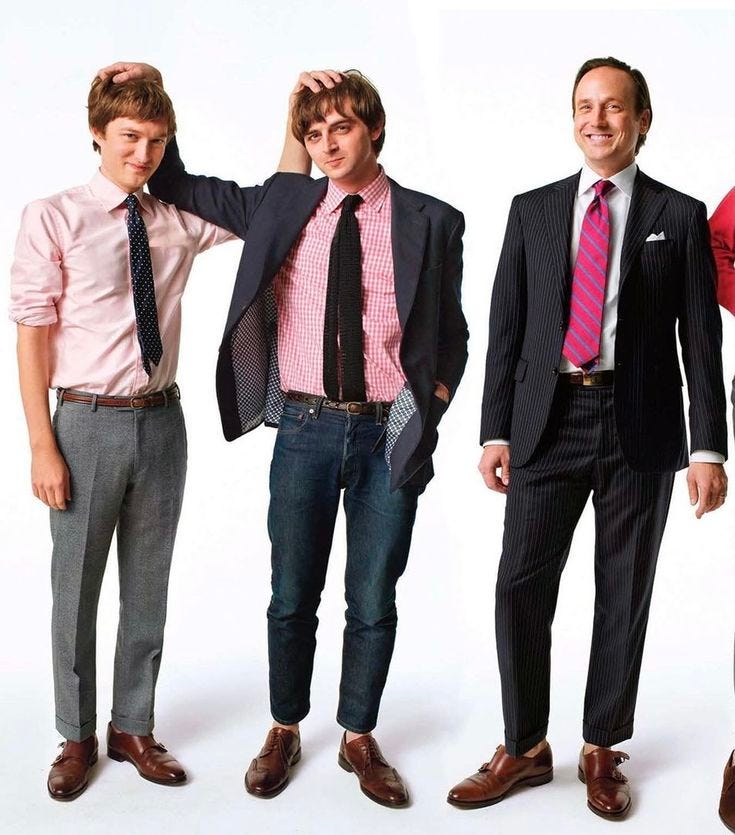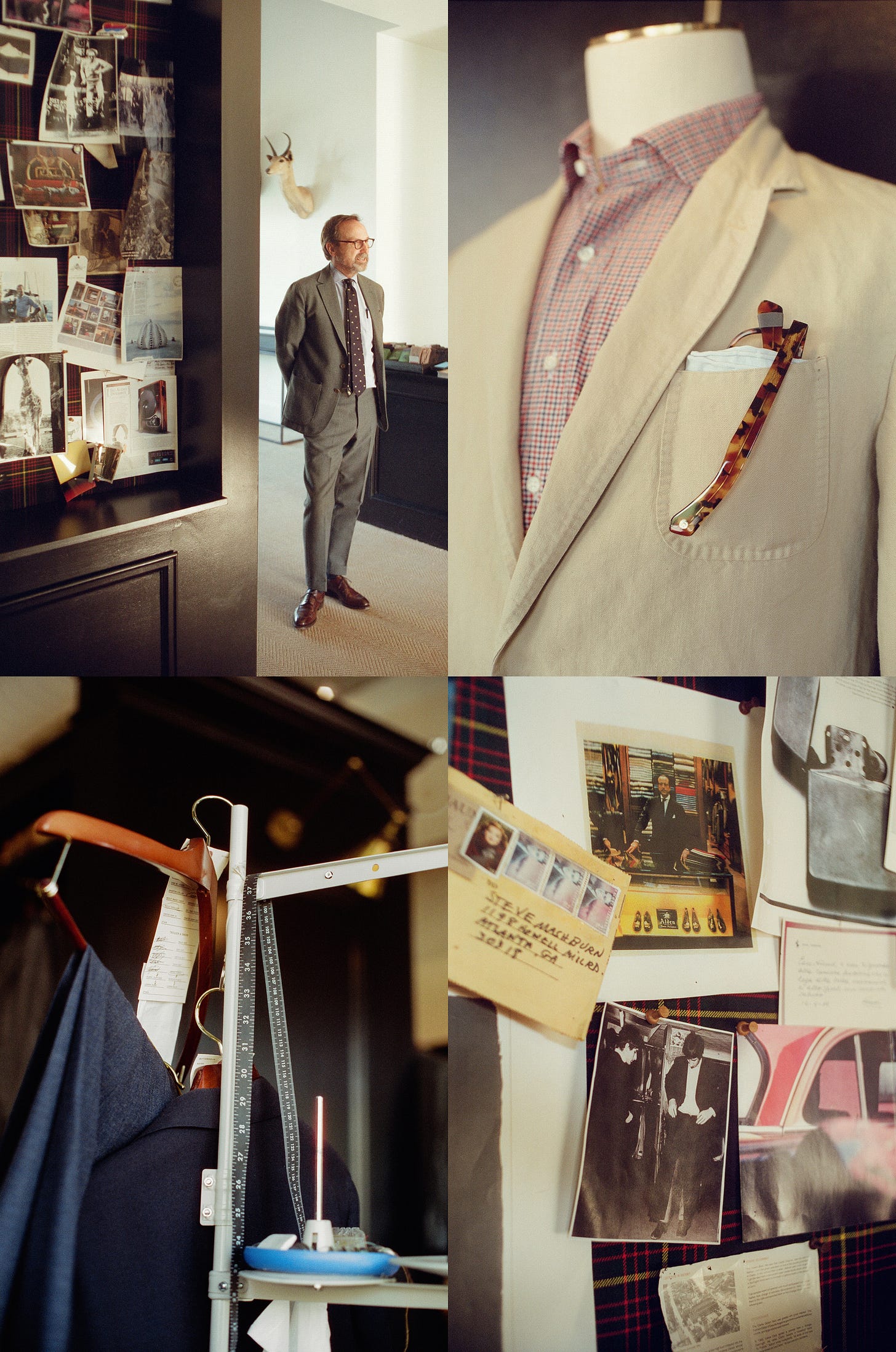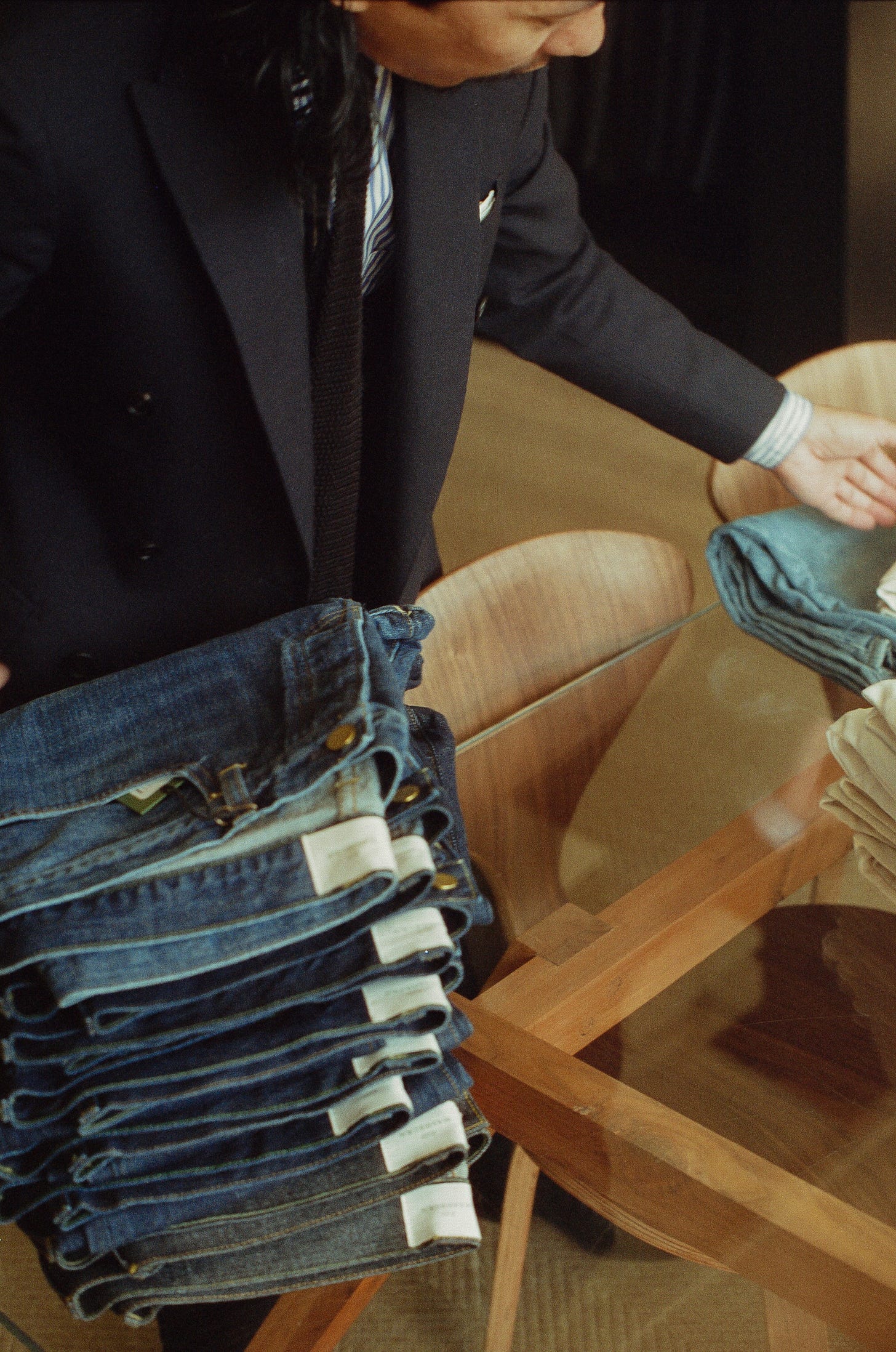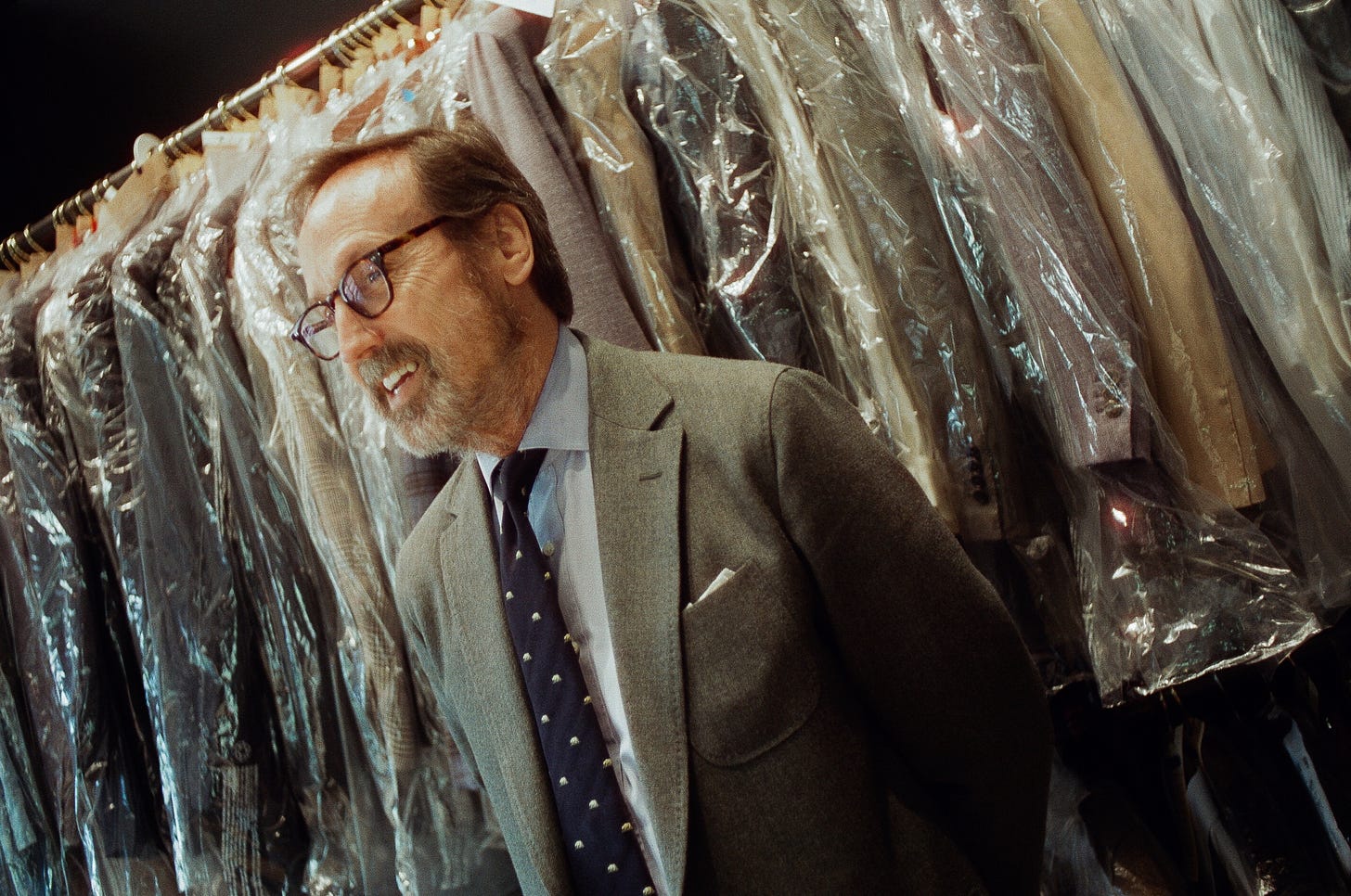My conversation with Sid Mashburn
Chatting with the menswear legend about growing up in Mississippi, building without asking for permission, what he learned under Ralph Lauren, and why hospitality matters more than clothing.
There’s a photo that lives rent-free in my head.
I wanna say it’s from an old profile that GQ did on Sid Mashburn years ago (circa ‘08) when he first opened his eponymous men’s shop in Atlanta’s up-and-coming Westside neighborhood.
The fits leaned a little slim, but I was enamored by the color pops, the way the suiting draped, and the golden era of sartorial prep we were lucky enough to live through.
This is that photo.
I first stumbled upon Sid and his work as a teenager, where my only outlets for discovering good taste was through Wordpress and Tumblr. He immediately became a beacon for good taste and muse for personal style.
Being from America’s Deep South (I’m a Tennessee boy at heart), and having grown up in rural towns, finding any semblance of creativity, culture, and style was hard to come by.
But if you’ve had the pleasure of meeting someone like Sid, you know what a radiant character he is. And you quickly realize that the way he treats people isn’t some kind of shtick—it’s who he is.
He treats people like he’s got all the time in the world. He shakes your hand, looks you in the eye, and remembers your name like you’re one of his own.
And that’s the kind of hospitality and care we often miss in retail.
I had the chance to sit down with Sid last year and talk shop on all the things. We went deep on everything from his upbringing in Mississipi, his first retail job, a one-way ticket to NYC to work in fashion, landing his first job at J.Crew (when it was a catalog in New Jersey), climbing the menswear ranks at Tommy, Ralph, and Lands’ End, and finally making his way home to ATL where finally opened his first men’s shop.
It’s now expanded into locations across the US, and what’s most impressive about Sid is how he’s stayed the course through many iterations of his brand.
We hope you enjoy this conversation.
PS — huge thanks to the homie Ray Spears for photographing Sid at his flagship spot for us.
Please give Ray a follow and reach out if you want to work with ‘em!
Clayton Chambers: Sid, appreciate you taking the time. I feel like our worlds have kind of orbited around each other for a while, but it’s good to finally sit down properly.
Sid Mashburn: Yeah, man, likewise. I think we met in the store before, right?
CC: We did—years ago. But even before that, I feel like I got to know you through that GQ piece years ago. That one really stuck with me. I was just starting to figure out my own style, and seeing how you built something so personal and intentional really resonated.
SM: That was a fun one. We had no idea what we were doing back then. Still don’t, some days.
CC: That makes two of us. You’ve been in this world for a long time—Ralph, Tommy, J.Crew—but it all started in Mississippi, right? That’s not exactly the first place people associate with menswear.
SM: No, it’s not. But I grew up around clothes. My grandparents were merchants—they had a furniture store, hardware store, even a clothing store at one point. My sisters were older than me, and they were into fashion. There were always magazines around the house—Seventeen, Glamour, Mademoiselle. I didn’t realize it at the time, but I was absorbing all of it. And I loved shopping. Whether it was the grocery store or a roadside Stuckey’s, I just dug the experience of picking things out.
CC: So when did it shift from interest to obsession?
SM: Probably when I was 15. I had just gotten my driver’s license, and the first place I went wasn’t to a friend’s house or a football game—I drove straight to a clothing store to ask for a job. I wanted to be around it.
I ended up working at this place in Jackson, Mississippi, called The Rogue, which was one of the best menswear stores in the country at the time. They had all the right brands, all the right people working there.
It was like a little fraternity—one guy could talk about literature, another knew everything about cars, another was obsessed with music. It was this mix of culture and style, and it just clicked for me.
CC: Sounds like a real creative incubator. Was New York always the goal, then?
SM: Yeah, I graduated from Ole Miss and went straight to the city. And let me tell you, they were pulling the straw out of my hair the second I got there. Total country boy. I wanted to be a designer, but I didn’t have the credentials to get into Parsons or FIT.
So I got a job at a menswear store, Frank Stella, and started figuring it out from there. A guy from British Khaki came in one day and asked if I wanted to do sales for him. I said, “Sure—if you teach me how to design.” And that’s how I learned.
Just by doing it.
CC: That’s wild. And that led you to J.Crew?
SM: Indirectly. I met my wife, Ann, in New York—we actually met on the beach. She was working at Vogue at the time, and a friend of hers left to work for this startup catalog company in Jersey. She told me I should go talk to them. Turned out to be J.Crew. I somehow talked my way into being their first menswear designer in 1985.
CC: No big deal. Just the first guy to design J.Crew menswear.
SM: Yeah, man, it was a blast. We were figuring it out as we went. At the time, we were doing these unisex pieces—men’s chinos and shirts that they’d tweak for women. But we started playing with the idea of a full menswear line, and that’s how we landed on things like the barn jacket.
CC: And Ann was working in the Devil Wears Prada world of Vogue at the time?
SM: Exactly! She was basically Anne Hathaway’s character in real life. That whole high-pressure, high-fashion environment—it was the real deal. We joke about it now, but it was intense.
CC: That barn jacket is legendary.
SM: It was kind of a Frankenstein’s monster—part Barbour, part LL Bean, part old hunting coat I found in a thrift shop. It was oversized, a little preppy-sloppy, and just worked.
Once it hit, we got a little more freedom to push things further—tailored goods, sport coats, dress shirts. That’s when we really became a proper menswear brand.
CC: Then came Ralph. What was that transition like?
SM: I got recruited from J.Crew to Polo. My interview was with Ralph and his brother Jerry, and at one point, Ralph jokingly goes, “He’s stealing all my ideas.” He was half-kidding, half-not. J.Crew had this younger, cooler thing going on that was really resonating. And he wanted to bring some of that energy back to Polo.
CC: That must’ve been like getting a PhD in style.
SM: Exactly. J.Crew was loose—we could do anything. Madras anoraks, polka dot shorts, fatigue sport coats. There were no rules. But Polo? That was a different beast. Ralph and Jerry were meticulous about every detail—the color of a button, the weight of a fabric, the way a collar rolled. It was a masterclass in branding and consistency. I learned a ton.
CC: And then Tommy. Another massive shift.
SM: Totally different. Tommy was smart, man. He understood scale and marketing in a way that was ahead of its time. I was there in ’97, working on his high-end collection line—basically his version of Purple Label.
The idea was to elevate the brand in Europe and prove that Tommy wasn’t just about big logos and baggy jeans. It was cool to be part of that.
CC: That’s something people really connect with—you walk into a Sid Mashburn store, and you just feel it. It’s not just racks of clothes, it’s an energy.
SM: That’s the goal, man. It’s all about taking care of people. I tell my team all the time—remember names, remember faces, make people feel like they belong. That’s what makes a great shop.
If someone walks in and you remember their name, what they bought last time, or just what they were wearing, it changes the whole experience. It’s hospitality. The best shops aren’t just about selling clothes, they’re about making people feel at home.
That’s how you build a relationship—by actually caring about the person in front of you.
CC: And you’ve mentored a lot of younger guys along the way—Mark Anthony Green, Pete, Matt Lambert. That’s something not every business owner prioritizes.
SM: It’s important. My dad was a people person, and I picked that up from him. It’s about inclusion. I want the shop to feel like a fraternity where everyone gets a bid. If you walk through our doors, you’re one of us.
CC: What’s next for you and the brand?
SM: We opened another store, this one in Nashville, with more in the future. But we’re not rushing. It’s about growing the right way, at the right pace. That’s how you keep it special.
CC: Sid, this was great. I could do this all day.
SM: Likewise, man. Let’s do it again sometime.










Recently met Sid at the flagship store in Atlanta, when working with a veteran sales person there - Randall. Sid validated everything he said in the article. He took the time to get to know me and my fashion interests - he quickly found out I go to OConnells in Buffalo (one of the last true great classic clothing stores in the US). I spent a few hours there working on rebooting my whole wardrobe approach post Covid. I work from home 1/2 time but I have a “get up, dress up, show up”policy which I need at 55. I’m not getting shit done in a hoodie except for cutting the grass or cleaning the grill. Having Randall and Sid in my corner has helped keep me focused and get through the day. It’s also helped me feel confident and win some negotiations and presentations in person as the best dressed person in the room many times. I feel like Bond in my Kincaid #3s every time. Thanks for the great interview I really enjoyed it.
Well done 👏